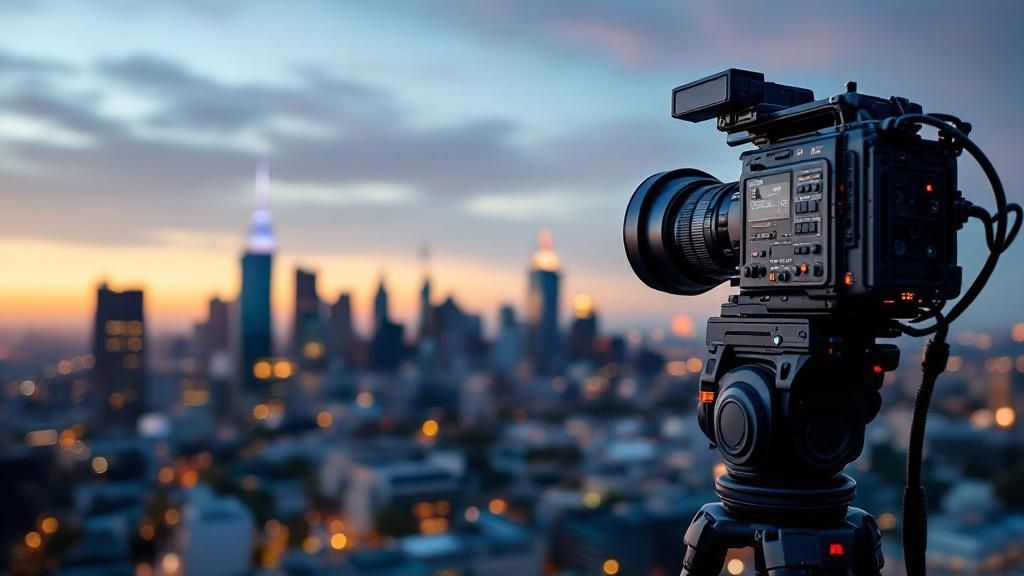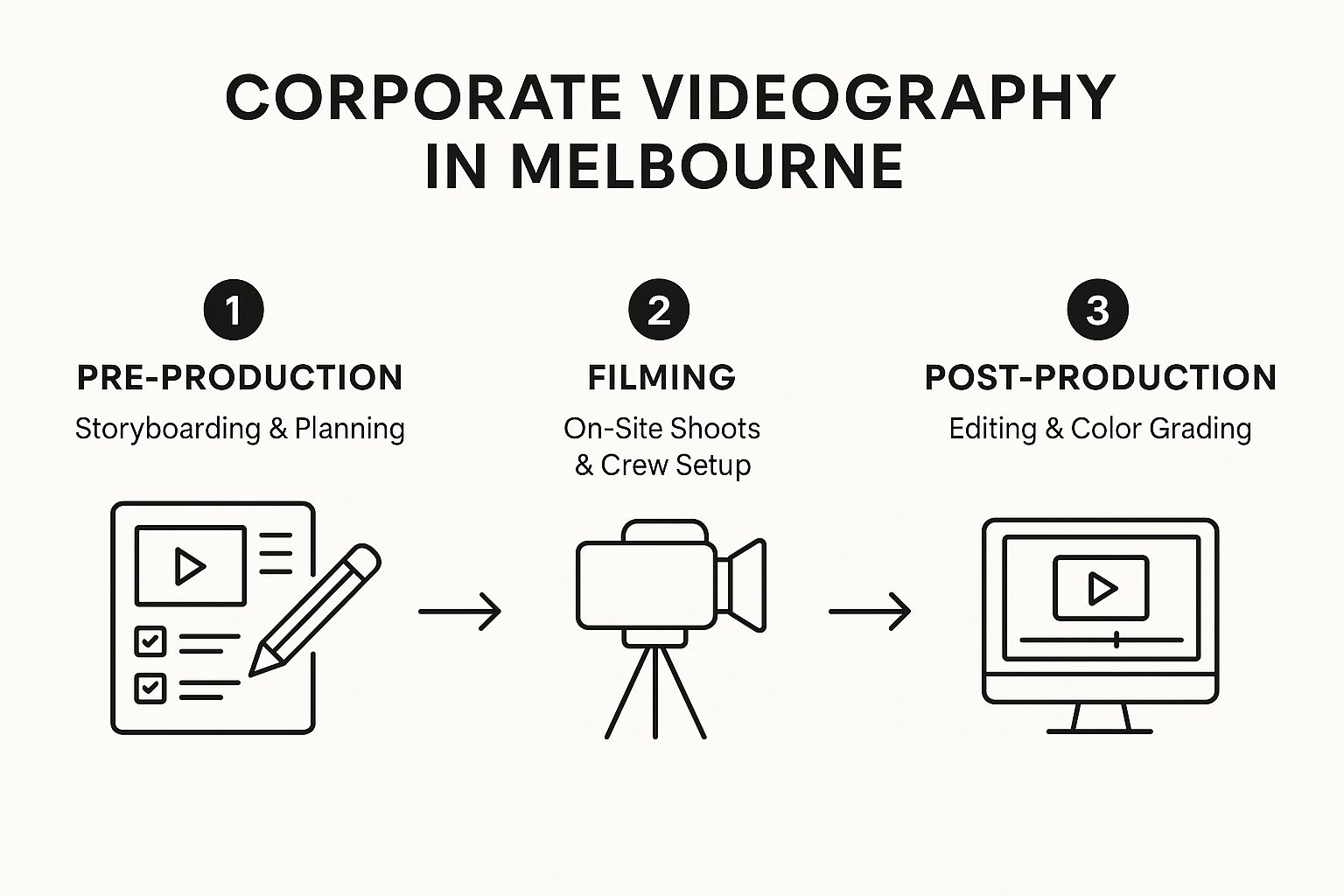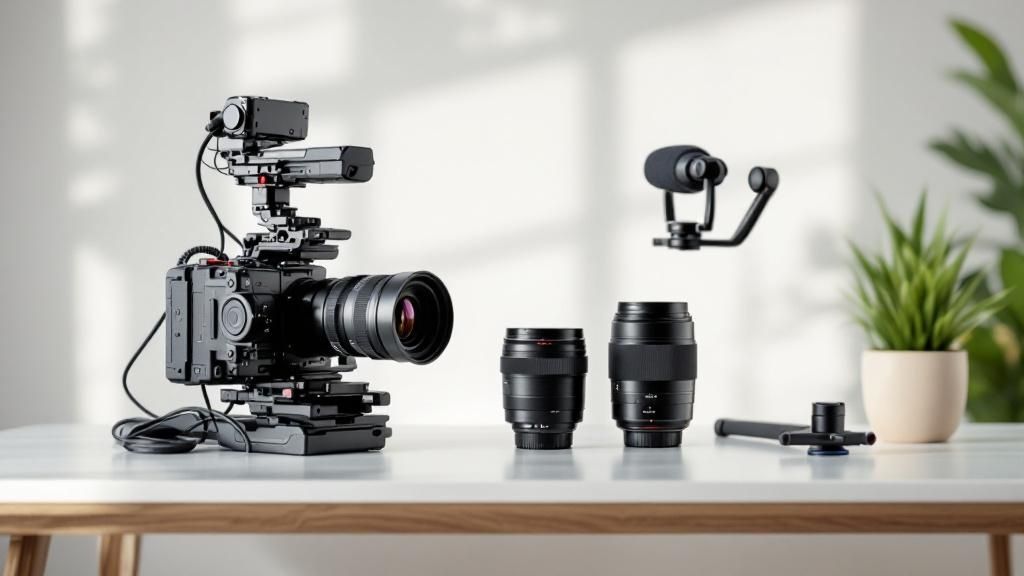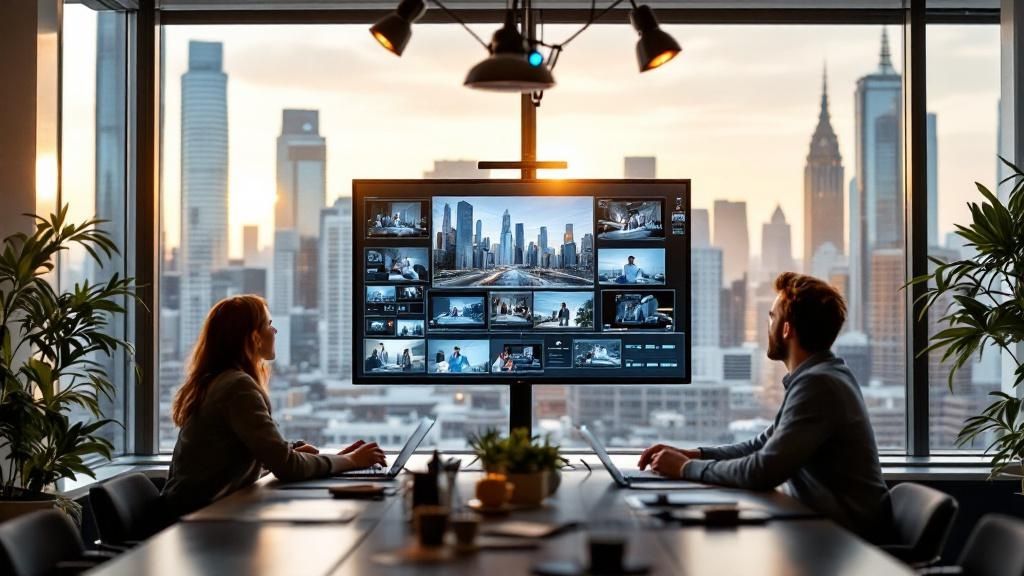
CONTACT
MENU
CLOSE

Imagine bottling up your brand's entire story, its mission, and its personality into a punchy two-minute video. That's what corporate videography is all about. It’s less about just hitting record and more about crafting a strategic tool to build trust, hook customers, and make your Melbourne business stand out.

Corporate videography is the art of creating video content with a clear business purpose. Forget shaky home movies; this is about producing a carefully crafted film that tells your company's story and gets a specific job done.
This isn't just about recording an event. It’s a professional service covering a massive range of video styles, each built for a different goal. The common thread? Every video is produced with intent, whether that's to build brand awareness, generate leads, train your team, or attract the best talent in town. It's about showing your value in a way that text and static images just can't touch.
The world of corporate videography in Melbourne is incredibly diverse, with a format for pretty much any business need. A good production company doesn't just point and shoot; they’re strategists who help you pick the right type of video to actually connect with your audience.
Here are some of the heavy hitters:
In a market as switched-on as Melbourne’s, the quality of your video is a direct reflection of your brand. A DIY video might feel like it's saving you a few dollars, but bad lighting, tinny audio, and shaky camerawork can do more harm than good. It just makes you look unprofessional.
Professional corporate videography makes sure your message lands with clarity and impact. It’s an investment in your brand’s reputation, helping you cut through the noise and be remembered for the right reasons.
The demand for quality content is real. The Australian film and video production scene is booming, with 8,332 businesses in the sector in 2023—a 6.8% jump from the year before, and Melbourne is a huge part of that creative energy. You can explore more on this industry growth from IBISWorld. This isn't just a trend; it shows how vital video has become for any business that wants to connect with its audience.
At the end of the day, professional videography isn't just about technical skill. It's about storytelling, strategy, and creating something that not only looks great but works hard for your business goals.
So, let's get past the buzzwords. The true value of professional video isn't some fuzzy, abstract idea—it’s about cold, hard results. This isn’t a line item for your marketing budget; it's a strategic investment that pays dividends across the entire business, from lifting website conversions to giving your search engine rankings a serious kick.
High-quality video has this unique way of making your brand stick in someone's head long after they've closed the tab.
Think of a local Melbourne tech startup using a clean, sharp product demo to nail its next funding round. Or a consulting firm building rock-solid credibility with authentic client stories. These aren't just creative projects; they are direct plays for growth and visibility.
To illustrate how these benefits translate into tangible business outcomes, here’s a quick breakdown:
This table shows that a strategic approach to video isn't just about looking good—it's about creating assets that actively work to grow your business.
At its core, a well-made video is your best sales tool. It can break down a complicated service, show off a product’s best features, and forge an emotional connection way faster than a wall of text ever could. The result? A more engaged, informed audience that’s much closer to saying "yes."
This impact isn't just a feeling; it's measurable:
Think of it like this: a professional video is your most effective 24/7 salesperson. It consistently pitches your value, builds trust, and guides people through the buying journey without ever needing a coffee break.
The numbers back this up. The Australian film and video sector—which corporate work is a big part of—has seen its income almost double, jumping from $2,272.8 million in 2015–16 to a massive $4,575.3 million in 2021–22. And the crucial part? Over half of these productions were released online first. The future of business communication is undeniably screen-based, a trend you can explore further with data from the Australian Bureau of Statistics.
Beyond the immediate wins, professional video builds something more permanent: brand equity. It creates a consistent look, feel, and voice for your company, reinforcing who you are at every single touchpoint. That consistency is what turns a one-time buyer into a loyal advocate.
A polished video sends a clear message: you care about quality, and you’re a leader in your space.
It becomes a workhorse asset you can use everywhere—from your website's homepage to social media campaigns and email newsletters. This is how you make sure your investment keeps paying off long after the shoot is over. To squeeze every drop of value from your content, check out our guide on maximising ROI with effective video distribution strategies.
Ultimately, investing in professional corporate video isn't about making a single clip. It’s about building a library of powerful assets that elevate your brand, connect with your audience, and drive real, sustainable growth.
Turning a rough idea into a polished corporate video can feel like a mountain to climb, but in reality, it's a well-oiled machine. Any professional production house worth its salt follows a clear, three-stage path. It’s a process designed to make sure nothing gets missed.
Understanding how it works helps you know what to expect and where you can best collaborate to get the result you’re after.
Think of it like building a house. You wouldn’t just start pouring concrete without a detailed blueprint. The same logic applies here. The entire journey is broken down into pre-production, production, and post-production, ensuring the final video is solid, has a purpose, and lines up perfectly with what your business needs.
This is where the magic really happens. It’s the single most critical phase where the foundation for the entire project gets laid. So many businesses make the mistake of rushing through planning, but this is what separates a forgettable video from a great one. It's where your vision gets translated into an actual, actionable plan.
Here’s what goes down in pre-production:
You could say about 80% of the creative heavy lifting is done in pre-production. A solid plan is the best insurance you have for keeping the project on track, on budget, and on vision.
This infographic breaks down how each stage flows into the next in a typical corporate video project.

As you can see, everything builds on what came before it, which is why getting that initial strategy right is so important.
With the blueprint locked in, it’s time to roll. This is the part everyone pictures when they think of a video shoot—the lights, the camera, the action. It's when the director, cinematographers, sound recordists, and gaffers all come together to capture every piece of the puzzle from the storyboard.
Whether we’re on-site at your Melbourne office or in a dedicated studio, the crew’s job is to bring the script to life. This phase is purely about execution. It’s all about capturing beautiful, high-quality footage that will become the raw material for the final story.
Once the cameras stop rolling, the project heads into the edit suite. This is post-production, where all the raw footage is meticulously pieced together to create a seamless, engaging final video. It's a detailed process where several things happen at once.
This whole process ensures every element is working together to land the message with impact. If you want to see how these stages play out in a real project, you can get a behind-the-scenes look at how we create an engaging corporate case study video. The back-and-forth between our team and yours is what makes the final cut sing.

It’s the first question everyone asks, and rightly so: "How much is this going to cost?" The truth is, there's no price tag you can pull off the shelf for corporate videography in Melbourne. A video isn't a commodity; it's a custom-built tool for your brand.
Think of it like building a house. A single-storey, three-bedroom home has a different blueprint, different materials, and a different timeline than an architecturally designed, multi-level masterpiece. Both are houses, but the scope, complexity, and investment are worlds apart. Video works the same way.
Getting a handle on the moving parts will help you set a realistic budget and understand exactly where your investment is going.
Every video quote is a mix of time, talent, and tech. The bigger your creative vision, the more of each you'll need. These are the foundational elements that shape the bottom line.
Here’s what you’re paying for on shoot day:
The shoot is just the beginning. The edit suite is where the raw ingredients are turned into a compelling story, and this phase has its own set of costs. It's often where a good video becomes a great one.
Think of post-production as the fit and finish. The raw footage is your raw timber. The editing, colour grading, and sound design are the joinery, sanding, and staining that create a polished, final piece.
The main costs after the cameras stop rolling include:
To give you a clearer picture, we've broken down how these factors impact a project's budget in the table below.
Understanding these variables is key. It helps you see that you're not just buying a video; you're investing in a specific level of craft, creativity, and production value.
To put it all together, the cost of corporate videography Melbourne projects generally falls into a few brackets. Every project is different, but this should give you a solid idea of what to expect.
Entry-Level ($2,000 - $5,000): This budget typically gets you a straightforward, half-day shoot. Think a single-person interview or a clean testimonial video. The crew will be minimal, and the post-production will be clean and simple with basic graphics and licensed music.
Standard Professional ($5,000 - $15,000): You're in the realm of a full-day shoot at one or two locations. This is perfect for a high-quality brand message video, a company profile, or a detailed explainer. This budget allows for a slightly larger crew, more advanced gear, and a more polished edit with some custom graphics.
Premium Brand Film ($15,000+): At this level, you’re commissioning a piece of cinematic storytelling—a brand film or a broadcast-quality ad. This budget can accommodate multi-day shoots, professional actors, unique locations, specialised gear like drones, and intensive post-production with high-end animation and sound design.

Picking the right creative team is probably the single most important call you'll make for your video project. The final product is a direct result of their technical skill, creative vision, and how well they manage the whole thing. In a city buzzing with talent like Melbourne, you’ve got options—but finding the perfect fit takes a bit of homework.
Think of it like hiring a key employee. You wouldn’t just glance at a CV; you’d dig into their approach, check out their past work, and make sure they click with your company culture. It’s the exact same deal when you’re choosing a partner for corporate videography in Melbourne.
Every production company has a showreel—a slick, fast-paced montage of their greatest hits. And while they look great, they don’t tell the whole story. You need to go deeper and watch full projects that feel similar to what you’re trying to create.
When you’re looking through their portfolio, ask yourself:
A strong portfolio shows they have the skills. A great one proves they can use those skills to solve business problems. For a deeper dive, our guide on how to find the best video production company in Melbourne has even more tips.
A great video doesn’t happen by accident; it’s born from a great process. Before you commit, you need to feel confident their workflow is organised, collaborative, and completely transparent. A chaotic production is a fast track to blown budgets, missed deadlines, and a final video that just misses the mark.
Don’t be shy about asking detailed questions about how they work.
A professional production partner should be able to walk you through their entire process, from the first chat to the final file delivery, with total clarity. If the answers are vague, that’s a red flag.
The Australian video production scene is booming, with industry revenue expected to rocket from USD 1.6 billion in 2023 to over USD 20 billion by 2030. Here in Melbourne, the best studios are already using advanced virtual production to push creative boundaries. You need a partner who is not just creative but also switched on and thinking about what’s next.
When you sit down with potential partners, go in with a checklist. Their answers will tell you everything you need to know about their experience, professionalism, and whether they’re the right fit for your brand.
Here are a few essential questions to get you started:
Choosing the right partner isn't just about finding someone who makes nice videos. It's about finding a team that creates results—a blend of creative chemistry, a proven process, and a shared vision for your goals.
Stepping into the world of corporate videography always kicks up a few questions. You know you need video, but the nuts and bolts of how it all works can feel a bit fuzzy. This is where we clear the air, answering the most common queries we get from businesses here in Melbourne.
Think of this as your pre-flight checklist. We'll tackle the practical stuff: timelines, video length, who owns what, and whether you should put your own team on camera. The goal is to give you the clarity and confidence to get your project off the ground.
This is usually the first question on everyone's mind, and the honest answer is: it depends entirely on the complexity of the vision. There's no one-size-fits-all timeline. Every video has its own creative ambition and unique demands.
A simple, single-location interview video? We can often turn that around in as little as one to two weeks, from the first call to the final file. That usually involves a half-day shoot and a pretty straightforward edit.
On the other end of the spectrum, a more ambitious brand film could take six to eight weeks, or even longer. That extended timeline accounts for the deep work in pre-production—scripting, storyboarding, location scouting—plus filming across multiple Melbourne spots, maybe with professional actors and a larger crew.
A professional production partner will always lay out a detailed, transparent timeline before a single frame is shot. This roadmap ensures everyone is on the same page and keeps the project humming along.
The whole journey breaks down into three key stages:
Ultimately, the timeline is a direct reflection of the creative scope. A clear brief and decisive feedback from your end also go a long way in keeping things moving efficiently.
There's no golden number. The "perfect" length is all about two things: its purpose and—most importantly—its platform. Where your audience is watching dictates everything.
For social media feeds like Instagram or LinkedIn, short and sharp wins the day. You want to aim for 60 to 90 seconds. People are scrolling fast, and you need to make an immediate impact to stop them in their tracks.
When it comes to your website's homepage or a key landing page, you have a bit more breathing room. A video in the two-to-three-minute range is often the sweet spot. It's long enough to tell a compelling brand story or explain a service without your viewer's attention drifting.
The golden rule is simple: match the video’s length to its context. A video that’s perfect for one platform might be completely ineffective on another. Strategy is everything.
The main exception here is internal communications, like detailed training or onboarding videos. In that context, length is far less of a concern. You have a captive audience that needs the information, so these videos can be as long as necessary to get the job done right.
This is a brilliant and crucial question to ask any potential production partner. The ownership of all the raw, unedited footage is a standard—and vital—part of any professional video agreement. You need clarity on this from day one.
Typically, the production company retains the copyright and ownership of the raw footage. The fee you pay covers the licence to use the final, edited video for its agreed-upon purpose. This is industry standard practice, protecting their creative work and assets.
Now, if you think you might need the raw files for other projects down the line—maybe for a future ad campaign or some internal edits—you need to negotiate this upfront. Most production companies are happy to arrange a transfer of ownership, but it almost always comes at an additional fee. This "buyout" cost covers the full value of those raw assets.
Make sure you have this conversation during the quoting phase so it can be built into the agreement. Leaving it until after the project is finished can create headaches and unexpected costs. A clear contract is your best friend here.
Absolutely. Featuring your own team can be a fantastic move. It adds a layer of authenticity and humanity that actors often can't replicate, building immediate trust with your audience.
But—and this is a big but—it needs some careful planning. You want to choose team members who are genuinely comfortable, confident, and enthusiastic about being on camera. Forcing a shy or unwilling employee into the spotlight rarely ends well for anyone.
To make sure it works, follow these simple steps:
For roles that are heavily scripted or demand a more polished performance, hiring professional actors is usually the smarter investment. Your corporate videography partner in Melbourne can help you weigh the pros and cons and figure out the best approach for your specific goals.
Ready to tell your brand’s story with cinematic quality and strategic purpose? At WVFRM, we create human-centred videos that connect with audiences and drive real action. Let's create something memorable together.
Article created using Outrank